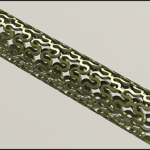Zn-based alloys have been recognized as highly promising bioabsorbable materials for cardiovascular stents, due to their biocompatibility and, more importantly, favorable corrosion rates as compared to Mg alloys. However, both low tensile strength and intrinsic mechanical instability arisen from strong strain rate sensitivity and strain softening behavior make development of Zn alloys challenging for vascular scaffolding applications. In our new study published in Acta Biomaterialia and entitled Towards revealing key factors in mechanical instability of bioabsorbable Zn-based alloys for intended vascular stenting, which was carried out in collaboration with the researchers from the University of Sheffield and University of Oxford, we developed, processed and characterized binary Zn-4.0Ag and ternary Zn-4.0Ag-Mn alloys. An experimental methodology was designed by cold working followed by a thermal treatment on extruded alloys, through which the effects of the grain size and precipitates could be thoroughly investigated. Microstructural observations revealed a significant grain refinement during the cold wire drawing, leading to an equiaxed ultrafine grain (UFG) structure with an average size of 670 nm and 240 nm for the Zn-4.0Ag and Zn-4.0Ag-0.6Mn alloys, respectively. Mn showed a powerful grain refining effect as it promoted the dynamic recrystallization and hindered the growth of the UFG grains during the drawing process. In addition, cold working resulted in dynamic precipitation of markedly fine AgZn3 particles, distributing throughout the Zn matrix. Such strain-induced precipitates triggered mechanical degradation through an activation of Zn/AgZn3 boundary sliding, exhibiting maximum elongation of 430% and 203 % at the strain rate of 3.3 × 10−3 s−1 for Zn-4.0Ag and Zn-4.0Ag-0.6Mn, respectively. The observed precipitation softening phenomenon caused strong strain rate sensitivity and distinct strain softening behavior in the cold drawn alloys. Short-time annealing significantly mitigated the mechanical instability by reducing the AgZn3 volume fraction and thus, decreased the contribution of Zn/AgZn3 boundary sliding. The ternary alloy wire showed superior microstructural stability as compared to its Mn-free counterpart due to the pinning effect of nanosized Mn particles on the grain boundaries, restricting the grain coarsening. The corrosion results revealed that the microstructural manipulation strongly influenced the corrosion behavior of the Zn alloys so that the cold drawn wires exhibited intensive pitting corrosion. However, a shift of the corrosion regime from localized to a more uniform was observed after applying the heat treatment, mainly due to the dissolution of AgZn3 precipitates.
Functional materials/surfaces, bioabsorbable materials, and natural minerals
Formulation, separation, processing, characterization, and application
-
Recent Posts
Archives
- August 2022
- June 2022
- May 2022
- December 2021
- July 2021
- March 2021
- January 2021
- December 2020
- November 2020
- July 2020
- March 2020
- February 2020
- December 2019
- November 2019
- September 2019
- August 2019
- July 2019
- June 2019
- May 2019
- April 2019
- March 2019
- February 2019
- January 2019
- December 2018
- November 2018
- August 2018
- July 2018
- June 2018
- April 2018
- March 2018
- February 2018
- January 2018
- December 2017
- November 2017
- October 2017
- September 2017
- August 2017
- July 2017
- June 2017
- May 2017
- April 2017
- March 2017
- February 2017
- January 2017
- December 2016
- November 2016
- October 2016
- September 2016
- August 2016
- July 2016
- June 2016
- May 2016
- April 2016
- March 2016
- February 2016
- January 2016
- December 2015
- November 2015
- October 2015
- September 2015
- August 2015
- July 2015
- June 2015
- May 2015
- April 2015
- March 2015
- February 2015
- December 2014
- November 2014
- October 2014
- September 2014
- April 2014
- January 2014
- October 2013
- July 2013
- June 2013
- May 2013
- April 2013
- March 2013
Categories

